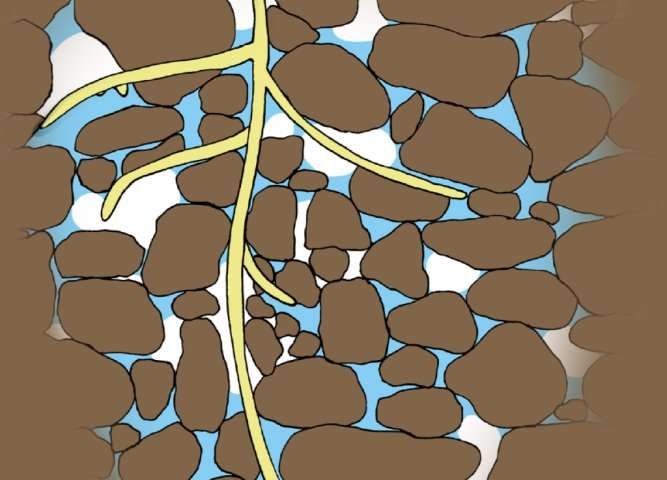Seeing in the dark—how plant roots perceive water through growth

Without eyes, ears, or a central nervous system, plants can perceive the direction of environmental cues and respond to ensure their survival.
For example, roots need to extend through the maze of nooks and crannies in the soil toward sources of water and nutrients. The various ways that plants guide this branching to take advantage of their environment is of great interest to scientists and of potential use by farmers in need of crops that produce more food with fewer resources.
Carnegie and Stanford University biologist José Dinneny has spent years studying how root growth responds to water, particularly through a phenomenon called hydropatterning, which allows plants to optimize root branching to maximize water uptake.
Just like how plants branch out above ground to gain access to sunlight, plant roots form a branching underground network, with lateral roots growing out from a main axis. The structure of these root system networks must be regulated in ways that optimize soil exploration, while limiting expansion into water-poor regions.
"We knew plants were doing this—branching toward water—but not the mechanism of how the plant was perceiving and reacting to this environmental signal," Dinneny explained.
He and Stanford graduate student Neil Robbins II set out to determine whether a plant root's observed ability to encourage branching toward moisture and discourage branching into dry soil is localized to any part of the root, or is shared by the whole root structure.

"By understanding where the root perceives water we might get clues as to how the plant performs this remarkable task," says Dinneny.
Using both fine-scale microdissection and mathematical modeling approaches, they found that the tip of the root where cell expansion drives growth is uniquely able to perceive and respond to moisture cues by shaping the direction in which the root branches out into the soil. The use of mathematical modeling showed that the perception of water as observed by water movement into the root was dramatically affected by the root growth rate.
Lead author Robbins commented: "When root growth slowed down, the root's ability to respond to the direction of water was strongly diminished. This work indicates that the active process of water uptake by the root is necessary to see where water is in soil water and respond developmentally to this key environmental cue."
To place this work into context, it is important to realize that little is understood about how plants perceive the abundance of water in the environment and most work has focused on the signaling events that happen at the cellular level.
Robbins' and Dinneny's work, published in Proceedings of the National Academy of Sciences, shows that the very process of growth itself induces a physical state in the plant that uniquely allows it to perceive at the organ scale the direction of a much-needed resource in its surroundings.
"The plant appears to see the direction of water only when it is trying to extract it from the environment," Dinneny said. "When cell expansion isn't driving growth, the ability to see the direction for water is reduced, and the root either can't see or doesn't care where water is and starts making branches in every direction."
Using the flux of water as a key metric of water availability may provide an important way in which the plant can convert the outside picture of where water is in soil into an internal biophysical pattern that plants can then interpret. Understanding how plants optimize this process for particular soil environments may enable the production of more water-efficient plants. When it comes to the importance of water for plants, a picture can be worth a thousand words.
More information: Neil E. Robbins et al. Growth is required for perception of water availability to pattern root branches in plants, Proceedings of the National Academy of Sciences (2018). DOI: 10.1073/pnas.1710709115
Journal information: Proceedings of the National Academy of Sciences
Provided by Carnegie Institution for Science





















